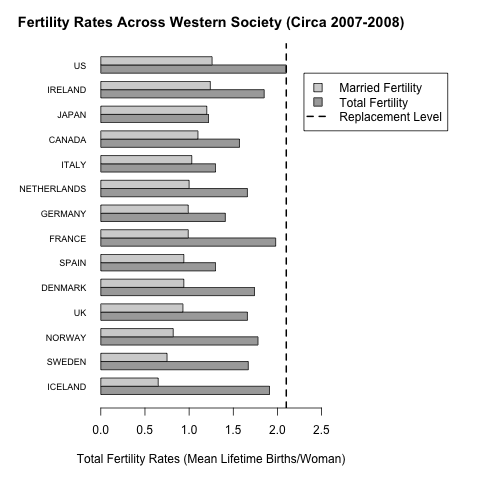Introduction
Western society is at great peril. We have forgotten the importance of children — and our individual responsibility to marry, then bear and raise children. While any society needs to produce at least 2.1 children/woman to maintain its population, many Western nations have fallen far below that threshold. And even those with more stable fertility levels do not have enough children born and raised within the context of marriage (Figure 1). Because our situation is dire, something drastic must be done. This proposal is one possible solution.
Every road children walk and every school they attend are courtesy of their parents and society. While we use it all the time, the abstract term “society” tends to conceal the fact that society consists of your family and other people’s children. The diversity of products and services you need but can’t produce is courtesy of other people’s (usually adult) children. Our nations are filled with wonders created and maintained by other people’s children. Instead of living hand-to-mouth as so many of our ancestors, we have abundance due to what other people’s children created for our use.
Because other people’s children produced food, other people’s children have transported it, and still other people’s children have processed it, almost all of us have access to delights that couldn’t even be imagined in simple societies. Likewise for a host of commodities that march out of our stores every day.
Our children are often taught by other people’s children, we are defended by other people’s children. Our politicians, our doctors, our lawyers — all are other people’s children. Because each of us has benefited so much from the labor of other people’s children, fairness and justice require that each of us contribute children so that others can likewise benefit. And because we benefit from other people’s children’s willingness to produce more than they consume, fairness and justice demand that we do the same.
This reality underlay the Roman Empire’s law forbidding inheritances to the childless, Jews requiring leaders have a son, and St. Paul’s admonition that younger widows remarry and have children. Past leaders of our civilization agreed: Fairness and decency demand that those who benefit from the efforts of other peoples’ children share in the sacrificial burden of bearing and raising children.
Does this mean that the voluntarily childless are stealing from their neighbors? Absolutely. We have all benefited from society. Therefore each of us must do our best to help provide a stable framework under which all can prosper. The demands of fairness and justice boil down to three basic expectations of every able-bodied citizen:
- to not trouble society;
- to produce more than we consume; and
- to get married and have children.
The Risk Of Demographic Suicide
The decline in birthrates is a crisis across Western society. Not only have fertility rates dropped precipitously, but more and more children are born out of wedlock (Figure 1). Traditionally, sex — within the context of marriage — was supposed to provide society’s next generation. But with the exception of the U.S., first-world countries are failing to produce the 2.1 children per woman-in-her-lifetime required for civilization’s continuance. Furthermore, even within the U.S. — given that almost 40% of American babies are now born to unwed mothers — the U.S. married fertility rate (i.e., lifetime births per woman born in marriage) is less than 1.3.
No matter what level a society’s current wealth, too few replacement children assure a bleak future. While Europe has an overall fertility rate of 1.5 per woman, many countries — including Italy, Moldova, Spain, and Poland — are at 1.3 or below. So, unless things change dramatically and without an influx of immigrants, in about 35 years, populations in these countries will be halved.
Stores and factories will close for lack of employees, insurance companies will go bankrupt, farms will be left fallow, etc. In these nations, it is only a matter of years until their children will be required to tend the weak, and it will be impossible to honor “social security.” Given economic interdependence, the demographic collapse of any first-world country is likely to send tremors throughout the West. Italy’s demographic decline is — even today — sucking mothers and potential mothers from nearby, poorer countries like Moldova to care for its aged. The wealth that Italy currently has is sufficient to drain enough motherhood from Moldova to exacerbate Moldova’s own demographic crisis.
Within a few years — 15 or 20 at the most for countries with rates of childbearing at 1.3/woman or lower — the plight of the aged and infirm will weigh on everyone’s conscience. But unless highly sophisticated robots can be employed, almost nothing will be possible to relieve them. The young will be too busy tending the engines of production to spare the time required to tend the old. And the young will be tempted as well to ‘follow the non-reproductive path’ of their elders, rather than the more difficult and expensive task of getting married and raising children.
Adding to these difficulties is the growing tolerance and outright acceptance of both non-marital and non-procreative sex, including homosexuality. In some ways, homosexuality is both a cause and a symptom of the West’s demographic decline. That those who enjoy a sexual lifestyle to the exclusion of getting married and having children are accepted and even given protected status means that the old rules have been abandoned in favor of a ‘psychiatric viewpoint.’
Figure 1

The old rules demanded that every able person contribute to society by not breaking the law, working a productive job, and getting married and raising a family. Meeting societal expectations was the first priority. Under the ‘psychiatric model,’ the individual patient or client is the center of the universe. Because they need help, or comfort, or advice, the client’s interests predominate over the needs or interests of society, and not the other way around.
In a clinic or hospital, where psychiatrists or psychologists are paid to care for the ‘mentally disturbed,’ this model makes some sense. But now the worldview associated with the ‘psychiatric model’ has permeated into all of society. No one thinks twice about allowing individual desires or ‘needs’ to trump social responsibilities. We are a ‘free’ society, after all, and people can do what they want.
Unfortunately, no society can long endure that enables and endorses such self-centered madness. The more individuals that are permitted to ‘absent themselves from social responsibilities’ because ‘they are uncomfortable with or unfulfilled with marriage and family responsibilities’ (e.g., gays, lesbians, and transgendered), the more others will follow them. Of course, not all who follow will want to become homosexual. Rather, if one group — declared ‘normal and healthy’ by the mental health establishment — is given a pass from some of the basic social duties, then others have the right to expect the same treatment for their own ‘lack of fulfillment or discomfiture.’
At some point — a point many Western countries have already passed — too many people exercise their ‘right to be themselves’ to such a degree that too few children are born, especially within marriage. Feeling like ‘not having a child’ provides sufficient justification for preventing conception or choosing an abortion. Likewise, no longer being ‘happy in marriage’ justifies divorcing or having an affair. Given our highly efficient contraception and abortion techniques, the result is a society with not enough individuals willing to honor their marital and reproductive responsibilities.
We have transformed ourselves into a population bristling with individual ‘rights’ instead of responsibilities. And the result is that the West is currently headed toward demographic suicide. To be sure, some countries are ameliorating their lack of children by importing workers. Additionally, many of those imported — before they become assimilated and adopt a more individualistic, psychiatric mindset — produce more than the requisite 2.1 children/woman. But these children are only a generation or two away from being fully assimilated, and as such may be a ‘mixed blessing.’ They also tend to provide a false sense of security since their fertility patterns do not match those of the rest of the culture.
The raw fertility numbers also paint only part of the picture. Because of rising out-of-wedlock birth rates (Figure 1), increasing numbers of the fewer children being born in the West do not enjoy the security of having a married mother and father. As a consequence, many of these children will disproportionately engage in violence, substance abuse, non-marital sexual exploration (some homosexual), and in short, be expensive citizens. Some will be so expensive and so far from fulfilling their own social obligations that, from a social standpoint, ‘it would have been better had they never been born.’
A Practical Solution
If marriage with children can be made sufficiently attractive, many young adults will opt out of their high levels of promiscuity, some will manage to contain their same-sex sexual desires and not engage in homosexuality, and others will be less likely to use contraception or obtain abortions.
The following proposal assumes that individuals in any society seek three basic things: goods, status, and power. Society can adjust the financial, status, and power rewards and incentives associated with almost any behavior or achievement. For instance, in the age of technology, those who create new products are highly prized and are typically given ample amounts of both money and status. While those who are married with children cannot be given the level of financial and status rewards proffered to inventors of useful new products, they can be given solid doses of both. Further, the right to vote is an important power in a democratic society. Under our proposal, those who are married with children would attain an electoral power not available to others. And our scheme is largely ‘revenue neutral,’ requiring modest increases in taxes, but mostly simply shifting who gets taxed and by how much.
A Practical Proposal to Strengthen Marriage and Family
| Policy Goal |
| Whereas a demographic crisis has swept across Western society, every reasonable step should be taken to encourage youth to get married, stay married, and have children. By encouraging people to marry and have children, we increase their chances of psychological well-being, opening the door to: A) greater transcendence (immortality through their children and grandchildren); B) more love (from their spouse, children and grandchildren); and C) greater stability (with many bonds of love helping to tie the individuals’ world together). Such encouragements also discourage selfish, anti-natal attitudes and behaviors |
| Policy Initiatives— |
| Money/Goods/Honor: |
| (1) Lottery & Internet Honor Roll. The names of parents and the number of their children would be honored on a government website under “Guarantors of XX’s (insert country name) Future” with their names and numbers of children. Public service announcements lauding those on the website would be made on a regular basis. Additionally, all those married-with-children would be enrolled in a free lottery. Each month, one eligible couple per legislative or Congressional district would be drawn at random and awarded, say $10,000 tax-free. News releases about the winning couples — including how they intend to spend their prize and how the prize affected them and their children — would be regularly released to the press so that families can get ‘face time’ in the media. |
| Comment: In the U.S., there are about 25 million married couples with children under age 18 — averaging about 57,000 in each of the 435 Congressional districts. One couple awarded $10,000 per district per month would cost approximately $52 million per year, $104 million if the award were raised to $20,000. A mere $1 billion per year would cover 10 winning couples per district per month. |
| Comment: As a rule, honor is a strong motivator. The honor of being on the official “Guarantors of XX’s (insert country name) Future” will motivate some to get married and have children. The lottery winners, and the attention they get, should also be a motivator. |
| (2) Restricting Inheritance. Mimic the early Roman Empire in which only the married with children could inherit. This could be implemented with the following rule: “only parents (of natural or adopted children) may inherit anything of value that exceeds the value of 5 ounces of gold from any person or entity unless the beneficiary is one of the bequeathing entity’s children under the age of 25 years.” |
| Comment: This provision follows Roman law, but acknowledges that we are richer today. The fixing of 5 ounces of gold, which equates to about $4,000-$5,000 today, is arbitrary. Parental estates should go almost entirely to their children who themselves have children. By age 25, most who hope to inherit should be married and have a child. This provision would have nothing to do with gifts. |
| (3) Shifting the Tax Burden to Non-Parents. To both encourage marriage with children, and make staying single or childless less fiscally attractive, the tax burden on those married with children would always be less than that placed on non-parents (other things being equal). In addition, those who married with children would always get a larger government pension. Granting married couples (or the widowed) who are raising their own or adopted children a substantial exemption per child (in the U.S., for instance, $10,000/child) from all federal taxes (including income, health care, retirement, etc.) would make having children in marriage fiscally attractive. This exemption would stay in force as long as the couple was married and raising children under the age of 19 years. Divorce or emancipation of the children would terminate the exemption. |
| Comment: Tax policy has a profound effect on what people do. Both the privelege of, and the actuality of, paying less in taxes will encourage citizens to get married and have children. The promise of a somewhat better pension, since all pensions depend upon the labor of one’s and others’ children, should also encourage marriage with children. |
| Power: |
| (4) Preference in Government Hiring. Other things being equal, any government job would first be offered to parents, with extra preference given to parents currently raising children under 19 years of age. |
| Comment: As government jobs are valued, giving the married with children preference in hiring encourages getting married and having children (but also gives primacy to unmarried parents supporting young children). |
| (5) Extra Voting Privileges. Those who contribute more to the future should have a greater say in how the future is addressed. Therefore, parents would be given an extra vote — ‘the parents’ vote.’ In any public election, where each citizen of appropriate age has a vote, a parent shall have two: one as a citizen and one as a parent who has contributed to the future. The ability to cast two votes will remain with a parent for life, since, because of their children and grandchildren, they will remain highly concerned about and invested in society’s future. |
| Comment: The honor and power of being able to cast two votes will encourage still others to get married and have children. Today, although a wealthy citizen has only a single personal vote, through expenditures they can exercise considerable influence on other citizens’ votes (e.g., George Soros). In the past, when scarcity ruled, the greater power of the economic elite made sense: the wealthy were more apt to be educated as well as more involved with society’s functioning. But the great need today is for more children, not more wealth. So giving more power to parents makes sense. Additionally, as parents are usually transformed by their children and parental concern to have a greater investment in the future, parents’ opinions about issues and candidates are bound to be better for society as a whole. |
| Comment: Note that parenthood does not entirely depend upon being married. Parents who are married, single, divorced or widowed would still have the ‘two votes’ power. However, parents who abandon or fail to support their children would be stripped of any extra voting powers. |
| Comment: Another anticipated benefit of multiple votes is a shift in political attention toward the family. Such a shift will encourage legislators to use their creative powers to pass laws further augmenting the attractiveness of being married and having children. |
| Comment: A Polish Parliamentarian, Tadeusz Woźniak, has suggested this idea might be better still if a parent got an extra vote for each child. Parents with one child would get one extra vote each, those with two children, two votes apiece, and those with 10 children ten votes, etc. Perhaps a limit of, say, 6 votes/parent would be more realistic, but whatever ‘works’ to generate more children within marriage should be implemented. Having a society that is ‘fair’ but dead for lack of children makes no sense whatsoever. |
| (6) Medical Treatment Preferences. Those who married with children, irrespective of their current age, would get preference for any organ transplant or exceptional medical treatment. |
| Comment: The promise of at least somewhat better medical care will be an encouragement to produce children for some. |
| Status: |
| (7) Banning Support for Non-Procreative Sex. The non-procreative, besides being made to pay a disproportionate amount of taxes, would be denied certain governmental support. Non-procreative sex acts or relationships based upon non-procreative sex acts would not be supported or sustained in any way by any government policy, law, or regulation. Favorable depiction of non-procreative sex acts in educational settings paid for by tax moneys or licensed by the government, or the use of government facilities such as streets for parades, walls of government buildings for posters, or government websites to promote the acceptance of non-procreative sex acts would be forbidden; likewise, those who are in or who engage in homosexual or other non-procreative relationships and those who are in or who engage in procreative relationships without being married would not receive any governmental support beyond that given to the unmarried-in-general. |
| Comment: This provision increases the status of the married with children by outlawing state sponsorship or support of homosexual acts, rectal sex, oral sex, or any other sexual expression other than penile-vaginal sex. This would not make such acts illegal, only that they can receive no state-sponsored support. It would outlaw state benefits or protections being given to homosexuals or unmarried heterosexuals who are living together that exceed those benefits and protections given other unmarried citizens. |
| (8) Banning Support for Cross-Gender Pretense. No one who pretends he is the opposite sex would receive assistance in getting drugs or operations to support his pretense from the state, nor would any government policy, law, or regulation grant such pretenders protections or benefits exceeding those of other citizens. |
| Comment: This provision increases the status of the married with children by removing state support for or in any way supporting those who pretend they are the opposite sex (e.g., the so-called transgendered or transsexual, as well as cross-dressers, etc.). |











